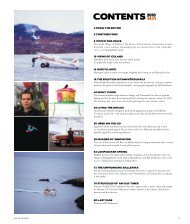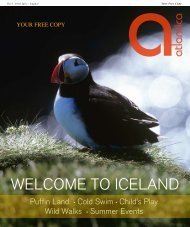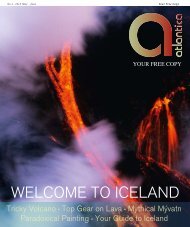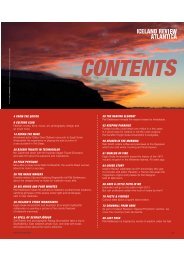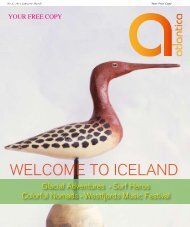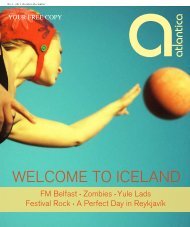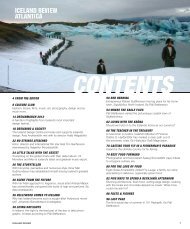Issues and Images - Iceland Review
Issues and Images - Iceland Review
Issues and Images - Iceland Review
Create successful ePaper yourself
Turn your PDF publications into a flip-book with our unique Google optimized e-Paper software.
Icel<strong>and</strong>ic Books:<br />
Surreal, Violent <strong>and</strong> Historic<br />
Our critics look at three different Icel<strong>and</strong>ic<br />
books by three different Icel<strong>and</strong>ic authors.<br />
It's a fact:<br />
2011 was a record year<br />
in book publishing in<br />
Icel<strong>and</strong>; 757 books were<br />
published, which is ten<br />
more than in 2010. That<br />
means that every day of<br />
the week, two books are<br />
published in Icel<strong>and</strong><br />
on average.<br />
From the Mouth of the Whale<br />
From the Mouth of the Whale (Icel<strong>and</strong>ic title: Rökkurbýsnir), the second novel<br />
by the Icel<strong>and</strong>ic writer Sjón to be translated into English, was shortlisted<br />
for the Independent Foreign Fiction Prize for 2012. This award for the best<br />
contemporary fiction in translation published in the UK in 2011 is unique in<br />
recognizing the importance of the translator. The magical work of translator<br />
Victoria Cribb preserves the special alchemy of the original Icel<strong>and</strong>ic language.<br />
From the Mouth of the Whale is set in seventeenth-century Icel<strong>and</strong>, the pre-<br />
Enlightenment period when science was just beginning to challenge religious<br />
authority. The protagonist <strong>and</strong> narrator, Jónas Pálmason the Learned, is a selftaught<br />
healer who is exiled for blasphemy <strong>and</strong> sorcery to desolate Gullbjörn’s<br />
Isl<strong>and</strong> off the coast of Icel<strong>and</strong> in the year 1635. Jónas is steeped in the superstition<br />
<strong>and</strong> lore of his time, predominantly Catholicism <strong>and</strong> an embryonic science<br />
that sought to underst<strong>and</strong> the world through cataloguing all its wonders.<br />
Jónas’s story is told in a stream of consciousness style that allows the reader<br />
to ride along on all the fantastical journeys, tangents, highways <strong>and</strong> byways of<br />
his mind. His me<strong>and</strong>ering narrative tells of his career as a healer of women’s<br />
diseases; his struggle to conquer a gruesome ghost; the deaths of his three<br />
children; his debates with his mentors, the Danish scholar Ole Worm <strong>and</strong> the<br />
Icel<strong>and</strong>ic poet Snorri Sturluson (real historical figures recruited into Jónas’s<br />
story); <strong>and</strong> his persecution for allegedly invoking the devil. The profusion of<br />
Jonas’s mind shows the richness of the world <strong>and</strong> of one man’s imagination,<br />
especially when stimulated into high gear by the lack of anything else around it.<br />
Sjón based Jónas on a real personage, Jón Guðmundsson the Learned, an<br />
Icel<strong>and</strong>ic self-taught sage of the seventeenth century who was exiled for sorcery,<br />
but left behind several important texts. The line between Jónas Pálmason<br />
the Learned <strong>and</strong> Jón Guðmundsson the Learned is unclear, <strong>and</strong> in typical postmodern<br />
style, the characters in Sjón’s book overlap, <strong>and</strong> time <strong>and</strong> boundaries<br />
blur <strong>and</strong> fade with tantalizing surrealistic echoes.<br />
Jonas slyly describes a speckled s<strong>and</strong>piper as a medium-sized fellow, with<br />
beady brown eyes, clad in a grey-brown coat, not unlike himself (or the author<br />
himself, perhaps). And at the end, Jón Guðmundsson the Learned steps into<br />
the book. Jón dreams of a man in a grey-speckled cap, with beady brown eyes<br />
surrounded by feathers, who says to him, “When you awaken you will have<br />
forgotten your name; for all you know, you may be called Jónas Pálmason.”<br />
The theme of magically transmogrifying material is woven throughout the<br />
book in references to talismans, tupilaks, bezoars, kidney stones, <strong>and</strong> diacodi—objects<br />
in which simple organic material becomes transformed <strong>and</strong> endowed<br />
with power. Just as the bird becomes the man becomes the writer, the<br />
shapes <strong>and</strong> colors of old Icel<strong>and</strong>ic texts are remixed in this modern text, so that<br />
translation becomes a form of alchemy in which the original wonder becomes<br />
a new kind of wonder.<br />
By Ann Sass.<br />
44 I&I



